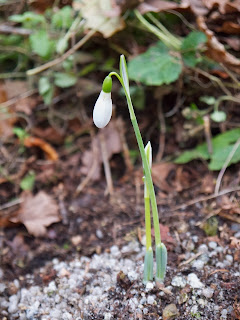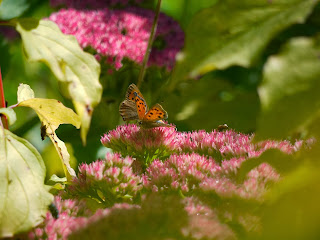I bury my head in work for a few days, look up again and suddenly it's the second week of October... How did that happen?
We've had a couple of generally very mild but often quite damp weeks, with higher than average temperatures accompanied by humid air, which the low autumn sun has struggled to make an impact on, meaning misty mornings, but bright or even sunny afternoons. We had a few hours of intense rainfall last week, but it was so concentrated that the stream level has not risen much from its mid-summer nadir. The warmth – especially at night – has meant that grass is continuing to romp away with spring-like vigour and we are having to keep the meadows 'topped' with the mower to give wildflower seedlings the space and light they need to develop.
Having been shamefully neglectful of this blog for a few days, I thought I would post a few shots taken last Sunday, 6 Ocotber – a beautifully warm, bright, often sunny day, when we worked happily in the garden from morning till dusk.
Here's a plant that has seemingly had more names than almost any I can think of! In years gone by – and I'm sure, for most gardeners, total lack of awareness of the racially offensive connotations – this used to be known by the common name of Kaffir Lily. More recently, it was perhaps better known by its scientific name
Schizostylis, which doesn't exactly trip off the tongue, while this beautiful pale-pink cultivar is popularly called 'Pink Princess'. But it doesn't end there... Checking the online RHS PlantFinder, I find that
Schizostylis coccinea 'Pink Princess' is now officially referred to as
Hesperantha coccinea 'Wilfred H. Bryant'. It's still lovely though!
This torpid, hibernating newt we found deeply buried when moving large stones and soil to make some new steps. Fortunately it was unharmed and crawled off to find a more restful spot to slumber until spring as soon as we released it somewhere safe.
This Red Admiral was drunk on the sweet, sticky innards of an
over-ripe fig, split open in the sun. This somehow captures the
decadence of the season; a time of plenty for humans and wildlife alike. Looking up at the open fruit reminded me of the lyrics to a Kate Bush track,
Eat the Music, which uses the opening-up of a closed fruit as a metaphor for human emotion:
"What am I singing? A song of seeds. The food of love".

But back to the frivolous. And it doesn't get any more frivolous than
the punch of colour provided by this fine display of mauve
Aster
'Little Carlow' (which looks great in spite of gross negligence in the
staking department – see post of 30 July) complemented by, or clashing
with – depending on your sensibilities – a backdrop of pale-yellow
Helianthus 'Lemon Queen', both simply smothered with butterflies and other insects.
Finally, a flowering shrub that we have loved since clapping eyes on a
magnificent specimen in full flower at Great Dixter one September
several years ago. This is the wall-shrub
Pileostegia viburnoides, whose
myriad starry white flowers exude a heady scent in the sun, which pulls
in insects from all over the garden. A real treat, at its best on warm
autumn days.

























 But back to the frivolous. And it doesn't get any more frivolous than
the punch of colour provided by this fine display of mauve Aster
'Little Carlow' (which looks great in spite of gross negligence in the
staking department – see post of 30 July) complemented by, or clashing
with – depending on your sensibilities – a backdrop of pale-yellow Helianthus 'Lemon Queen', both simply smothered with butterflies and other insects.
But back to the frivolous. And it doesn't get any more frivolous than
the punch of colour provided by this fine display of mauve Aster
'Little Carlow' (which looks great in spite of gross negligence in the
staking department – see post of 30 July) complemented by, or clashing
with – depending on your sensibilities – a backdrop of pale-yellow Helianthus 'Lemon Queen', both simply smothered with butterflies and other insects.













